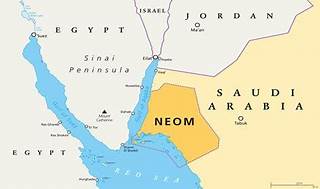Green hydrogen is a form of renewable energy that can be used to power vehicles, industries, and homes without emitting greenhouse gases. It is produced using electricity from renewable sources, such as solar and wind, to split water into hydrogen and oxygen.
Saudi Arabia, the world’s largest oil exporter, is investing in green hydrogen to diversify its economy and reduce its carbon footprint. The kingdom is developing a $5 billion project in NEOM, a new mega-city near its borders with Egypt and Jordan, that will be the world’s largest green hydrogen production facility.
What are the benefits of green hydrogen?
Green hydrogen is a form of renewable energy that has many benefits, such as:
- It is 100% sustainable and does not emit polluting gases during production or combustion.
- It can be used for various purposes, such as power generation, transportation, industry, and heating.
- It can reduce carbon footprints and help achieve net zero emissions by 2050.
How is green hydrogen produced?
Green hydrogen is produced by using renewable electricity from sources like solar or wind power to split water into hydrogen and oxygen through a process called electrolysis. This is different from other types of hydrogen, such as grey or blue, which are produced from natural gas and may emit greenhouse gases.
What are the applications of green hydrogen?
Green hydrogen has many applications, such as:
- Replacing existing hydrogen feedstocks in industries like chemical, steel, and refining.
- Heating buildings or industrial processes.
- Energy storage for balancing renewable electricity supply and demand.
- Alternative fuels for transport include cars, buses, trucks, trains, ships, and planes.
- Manufacturing of ammonia and fertilizers in the chemical industry.
NEOM Green Hydrogen Project
The NEOM Green Hydrogen Project is a joint venture between Air Products, a US-based industrial gas company, ACWA Power, a Saudi utility company, and NEOM, a special economic zone that aims to host 1 million people worldwide. The project was announced in July 2020 and is expected to start construction in March 2022.
The project will use 120 electrolyzers, each of them about 40 meters long, to split water into hydrogen and oxygen. The electrolyzers will be powered by 4 gigawatts of solar and wind energy from the NEOM region, which has abundant sunshine and wind resources. The project will produce 650 tons of green hydrogen per day, enough to run around 20,000 hydrogen-fueled buses.
The green hydrogen will be converted into ammonia for easy transport and storage. The ammonia will be shipped to global markets, where it can be used as a fuel or as a feedstock for various industries, such as fertilizers, chemicals, and steel. The project will also produce oxygen as a by-product, which can be used for medical or industrial purposes.
The project is expected to create thousands of jobs and contribute to the economic growth and diversity of Saudi Arabia. It will also position NEOM as a key contributor to the Kingdom’s Vision 2030 plan, which aims to reduce the dependence on oil revenues and transform the country into a global hub for innovation and sustainability.
Conclusion
The NEOM Green Hydrogen Project is a landmark initiative that showcases Saudi Arabia’s commitment to renewable energy and green hydrogen. It will be the world’s largest green hydrogen production facility, using solar and wind power to produce clean fuel for domestic and international markets. It will also support the development of NEOM, a new mega-city that will be a model for the future of living.


Land surveyor